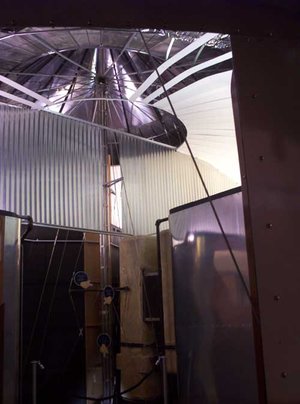Dymaxion house
|
|
The Dymaxion House was developed by inventor Buckminster Fuller to address several failures he perceived with existing homebuilding techniques.
Dymaxion_house.jpg
Fuller designed several different versions of the house at different times, but they were factory manufactured kits, assembled on site, intended to be suitable for any site or environment and to use resources efficiently. One important design consideration was ease of shipment and assembly.
Criticisms of the Dymaxion Houses include its supposed cookie-cutter approach to housing which completely disregarded local site and architectural idiom, and its use of energy-intensive materials such as aluminum, rather than low-energy materials such as adobe or tile.
| Contents |
History
Fuller's young daughter died from an infection contracted because they lived in poor housing during a Chicago winter. This horrid experience permanently changed Fuller's priorities. The first, most successful dymaxion house design was for the U.S.S.R. for temporary housing during WWII. It was mass-produced and based on tooling for a sheet-metal grain silo. Several hundred units were constructed and installed, before the war ended and the state housing ministry decided that the housing was unsuitable for permanent use. The grain-silo house was reported by inhabitants to be warm, easy-to-heat, well-lit, vermin-proof and arguably superior to the housing previously available at the installed sites.
The Siberian grain-silo house was the first system in which Fuller noted the "dome effect." Many installations have reported that a dome induces a local vertical heat-driven vortex that sucks cooler air downward into a dome if the dome is vented properly (a single overhead vent, and peripheral vents). Fuller adapted the later units of the grain-silo house to use this effect.
The final design of the dymaxion house used a central vertical stainless steel strut on a single foundation. Structures similar to a bicycle-wheel hung down from this supporting the roof, whilst beams radiating out supported the floor. Pie-shaped fans of sheet metal formed the roof, ceiling and floor. Each structure was assembled at ground level and then winched up the strut. The dymaxion house was the first conscious effort at an autonomous building in the twentieth century.
It used a packaging toilet, water storage and a vacuum-based wind turbine built into the roof. It was designed for the stormy areas of the world: temperate oceanic islands, and the great plains of North America, South America and Eurasia. At the time, solar cells were not available, so the wind turbine was the only practical way to provide electricity.
In most modern houses, laundry, showers and commodes are the major water uses, with drinking, cooking and dish-washing consuming less than twenty liters per day. The Dymaxion house reduced water use by a greywater system, a packaging commode, efficient horizontally-agitated laundry equipment, and a unique personal cleanser called a fogger.
The fogger used very fine particles of water dispersed by compressed air. The fogger permitted one to clean onself with only a cup or so of water. Fuller is reported to have said that it worked on the same principle as commercial degreasers, but with much smaller water particles to make it comfortable.
The real Dymaxion house
Only one Dymaxion house was ever constructed and lived-in. The prototype was purchased as salvage by an enthusiast after the venture failed. This prototype was constructed of aluminum, and remains in existence. It was inhabited for about thirty years, although as an extension to an existing ranch house, rather than standing alone as intended by Fuller. It was extensively restored and installed indoors in the Henry Ford Museum in 2001.
Regrettably, during erection, a crucial internal rain-gutter was omitted because the factory-trained technicians had already been laid off. The roof was designed to wick water inside and drip into the rain-gutter and then to the cistern, rather than have a difficult-to-fit, perfectly waterproof roof. The result was that the roof leaked terribly, as installed.
Another notable problem was that the large bearings around the edge of the suction wind-turbine rumbled loudly when it turned into the wind. It was eventually disabled. Some engineers have commented that this trait could be easily fixed with a different bearing system.
The packaging toilet was immediately replaced by a conventional septic system because the packaging plastic was not available.
Other features worked as advertised, notably the heating, and the passive air conditioning system, based on the "dome effect."
The inhabitants said that the bathroom was a particular delight. The children loved it for water fights because "it was absolutely indestructible as far as water was concerned." The bathroom consisted of two connected stainless steel bubbles, built as four nesting pieces. Each bubble had a drain. No area had a radius of less than four inches (10cm) to aid cleaning. The commode, shower, bathtub and sink were molded into the structural shell in one piece. One bubble contained a step-up ergonomic bath tub and shower, high enough to wash children without stooping, but just two steps (16" (40cm)) up. The oval tub had the controls mounted on the inside left of the entrance to the oval tub. The other bubble was the bathroom proper with commode and sink. The ventilation for the bathroom was a large silent fan under the main sink, which kept odors away from people's noses. All lighting was totally enclosed. The mirror had special features to keep it from fogging. A plastic version of the bathroom was available intermittently up until the 1980s.
The large wrap-around windows and lightweight structures were very popular with the children, who crawled on the windowsill, and twanged the bicycle-wheel-style main struts.
See also
External link
- Henry Ford Museum (http://www.hfmgv.org/dymaxion/opening.html) has restored the prototype and installed it in the museum.

